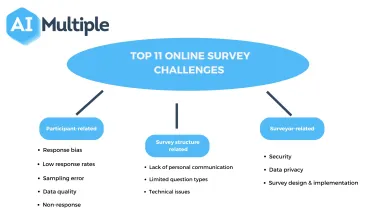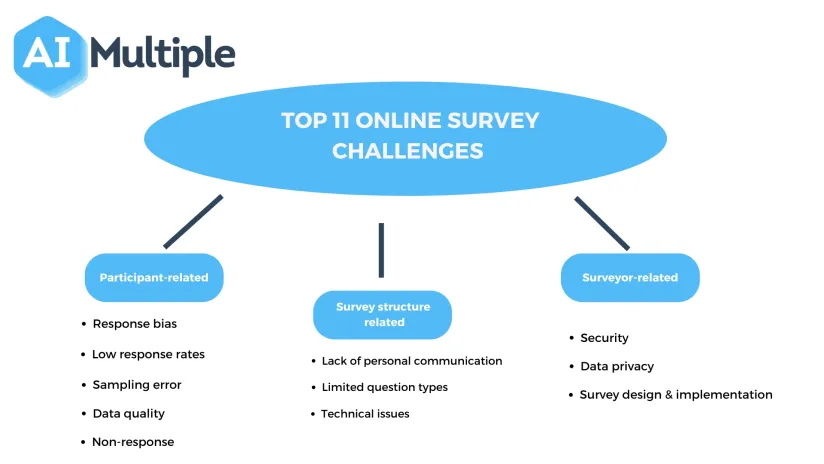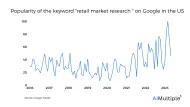11 Online Survey Challenges in 2024


Companies conduct online research to understand their customers better, and customers who have internet access can participate in surveys conducted online. However, gathering online data is more difficult than it appears. According to one study, the average response rates for online surveys in the US, the UK, and the Netherlands are 46%, 36%, and 33%, respectively.
To help business leaders and researchers improve their survey response rates, in this article we review the top 11 challenges of conducting online surveys and propose solutions to overcome them.
Top 11 online survey challenges
The most common online survey challenges are divided into three categories:
- Participant-related
- Survey structure-related
- Surveyor-related
Participant-related challenges
1- Response bias
Participants may not finish the survey or answer all questions honestly, which could influence the validity of the results.
2- Low response rates
Encouraging respondents to complete the survey might be challenging, which results in a low response rate and an unrepresentative sample.
3- Sampling error
Online surveys rely on self-selection, which can result in sampling bias if particular groups of people are either overrepresented or underrepresented in the sample.
4- Data quality
Some participants may intentionally give wrong answers in answering online surveys, which makes them susceptible to participant data entry mistakes and deliberate data fraud.
5- Non-response
In online surveys, non-response can be a serious problem as respondents might abandon the survey before it is finished or in the middle of it.
Survey structure-related challenges
6- Lack of personal interaction
Online surveys prevent direct communication between the surveyor and the respondent, which may restrict the surveyor’s capacity to ask follow-up questions or delve further into the participant’s responses.
7- Limited question types
Online surveys frequently include multiple choice or Likert scale questions, which may not be appropriate for obtaining complicated or nuanced replies.
8- Technical issues
Participants may be unable to complete the survey due to technical issues like website crashes or slow loading times.
Surveyor-related challenges
9- Security
Online surveys could be susceptible to hacking or other security breaches, jeopardizing the data’s accuracy and confidentiality.
10- Data privacy
Sensitive personal data may be gathered through web surveys, and this data must be safeguarded in compliance with data privacy laws.
11- Survey design and implementation
The survey’s design and implementation must be properly thought out to reduce the likelihood of response bias and increase sample representativeness.
These challenges highlight the importance of carefully planning and executing web-based surveys to achieve reliable and valid results.
Solutions for improving online survey research
1- Partner with crowdsourcing agencies
You can transfer the burden of the challenges to a third-party service provider. Crowdsourcing agencies handle the challenges of web surveys by
- providing participants with incentives
- improving the user experience
- enhancing the survey design
- using multiple channels to reach participants (e.g., social media, in-app notifications)
- providing secure data collection and storage
- maintaining compliance with data privacy
- offering participants technical assistance
These strategies help to minimize response bias, increase response rates, and ensure accurate and representative survey results.
For those interested, here is our benchmarking study on survey participant recruitment services.
2- Implement qualitative survey research techniques
Source: HubSpot
Figure 1. Types of qualitative research methods
Incorporating qualitative survey research techniques into online surveys can boost their quality by improving survey design, increasing data accuracy, and allowing for a more nuanced interpretation of the results. This results in a more accurate and representative picture of the population under investigation.
3- Use big data and AI technologies
Big data and AI technologies can greatly improve online surveys for corporations by:
- analyzing large amounts of data
- overcoming sample size limitations
- improving data quality
- improving and automating data analysis.
These technologies can aid in producing more accurate and representative results, lowering the risk of sampling error and response bias while also informing business decisions for growth.
Check out our data-driven list of market research tools if interested.
Here is also our data-driven vendor list of survey participant recruitment services and survey tools.
Please contact us if you have any additional questions about online surveys:

Cem is the principal analyst at AIMultiple since 2017. AIMultiple informs hundreds of thousands of businesses (as per Similarweb) including 60% of Fortune 500 every month.
Cem's work has been cited by leading global publications including Business Insider, Forbes, Washington Post, global firms like Deloitte, HPE, NGOs like World Economic Forum and supranational organizations like European Commission. You can see more reputable companies and media that referenced AIMultiple.
Throughout his career, Cem served as a tech consultant, tech buyer and tech entrepreneur. He advised enterprises on their technology decisions at McKinsey & Company and Altman Solon for more than a decade. He also published a McKinsey report on digitalization.
He led technology strategy and procurement of a telco while reporting to the CEO. He has also led commercial growth of deep tech company Hypatos that reached a 7 digit annual recurring revenue and a 9 digit valuation from 0 within 2 years. Cem's work in Hypatos was covered by leading technology publications like TechCrunch and Business Insider.
Cem regularly speaks at international technology conferences. He graduated from Bogazici University as a computer engineer and holds an MBA from Columbia Business School.
Sources:
AIMultiple.com Traffic Analytics, Ranking & Audience, Similarweb.
Why Microsoft, IBM, and Google Are Ramping up Efforts on AI Ethics, Business Insider.
Microsoft invests $1 billion in OpenAI to pursue artificial intelligence that’s smarter than we are, Washington Post.
Data management barriers to AI success, Deloitte.
Empowering AI Leadership: AI C-Suite Toolkit, World Economic Forum.
Science, Research and Innovation Performance of the EU, European Commission.
Public-sector digitization: The trillion-dollar challenge, McKinsey & Company.
Hypatos gets $11.8M for a deep learning approach to document processing, TechCrunch.
We got an exclusive look at the pitch deck AI startup Hypatos used to raise $11 million, Business Insider.
To stay up-to-date on B2B tech & accelerate your enterprise:
Follow on


Comments
Your email address will not be published. All fields are required.